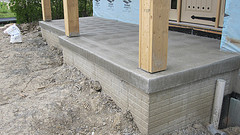Concrete Walks, Steps and Porches: 7 Tips for Success
 Handsome, hardwearing concrete walks, steps, and porches will form an impressive entree to any home. To achieve the best looking and most durable outdoor concrete, follow these 7 pro tips. They'll help you to understand the steps of readying your surface, preparing the concrete, and taking care of it after it has been laid.
Handsome, hardwearing concrete walks, steps, and porches will form an impressive entree to any home. To achieve the best looking and most durable outdoor concrete, follow these 7 pro tips. They'll help you to understand the steps of readying your surface, preparing the concrete, and taking care of it after it has been laid.
- Prepare the subgrade carefully before laying a concrete walk, steps, or porch. The subgrade should be uniformly compacted to help minimize cracking as the concrete settles. Make sure that your walkway will not be placed close to trees with large (or even potentially large) root systems, which can cause damage to the concrete as they grow.
- Mix ingredients in the proper proportions, according to weight. The Portland Cement Association specifies 11 percent cement, 26 percent sand, and 41 percent aggregate (crushed stone or gravel), plus 16 percent water and 6 percent air. It's best to thoroughly blend the dry components, together with an air entrainment agent, before adding water. Air entrainment increases the finished concrete's resistance to damage caused by freeze thaw cycling and the application of de-icing salt or other chemicals, while sufficient aggregate aids in forming a strong top layer.
- Use the correct compression strength. A compression strength of 400 PSI is recommended if the concrete is going to be exposed to de-icers, which are normally used on residential paths and stairways in the course of snowy Northern winters.
- Don't over-manipulate the concrete or add water when it is being finished. Otherwise, you're likely to end up with a weak, flaky upper layer formed of only water and paste, which is susceptible to spalling (AKA scaling). Spalling is the chipping and pitting of a concrete surface as the result of extremes of temperature. Though it does not significantly affect the strength of concrete walks, steps, and porches, nevertheless spalling will mar the beauty of the entrance to your home.
- Plan for control joints in walkways and other concrete slab structures. These are weakened lines cut so that the inevitable cracks which form in the concrete will be straight and regular, appearing as part of a pre-planned design on the surface rather than a blemish. In addition to the traditional sidewalk score lines, nowadays control joints can be part of a checkerboard pattern, faux stone effect, or other decorative concrete look.
- Allow the concrete to cure properly, starting immediately after it has been finished. This refers to a process of slowing down the concrete's drying over several days -- essential to produce strong, durable concrete. The concrete must be kept moist at all times during this period, especially if the weather is particularly dry and windy. There are several methods of dampening concrete during its curing: hosing it down, spreading with moistened straw or polyethylene sheeting, covering with a special curing blanket, or spraying the newly laid concrete with curing compound.
- Seal the concrete, either shortly after curing or at any point in its lifetime, to safeguard against extremely cold weather conditions and the havoc they tend to wreak. Sealing also protects against stains or efflorescence, the powdery residue that often forms on unsealed concrete.
Find a concrete contractor to install your walk, steps or porch successfully.
Laura Firszt writes for networx.com.
Updated October 22, 2018.
Looking for a Pro? Call us (866) 441-6648

Concrete Average Costs
Concrete Contractors Experiences

Concrete Driveway, Sidewalk And Walkway Just The Way We Wanted

Exposed Aggregate Driveway Replaces Unattractive Amosite Asphalt

Concrete Slab Installation For My Travel Trailer
Top Cities Covered by our Concrete Contractors
Austin
| Boston
| Charlotte
| Chicago
| Columbus
| Dallas
| Denver
| Detroit
| El Paso
| Fort Worth
| Houston
| Indianapolis
| Jacksonville
| Los Angeles
| Memphis
| Nashville
| New York
| Philadelphia
| Phoenix
| Portland
| San Antonio
| San Diego
| San Francisco
| San Jose
| Seattle
| Washington


